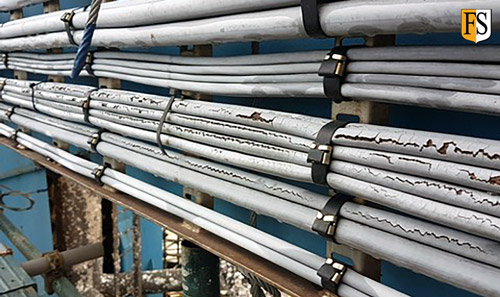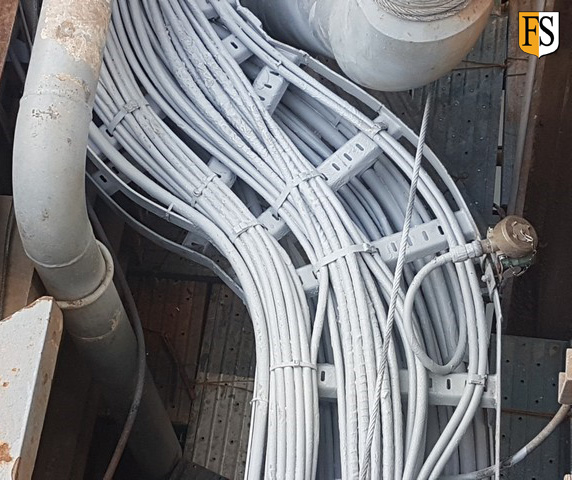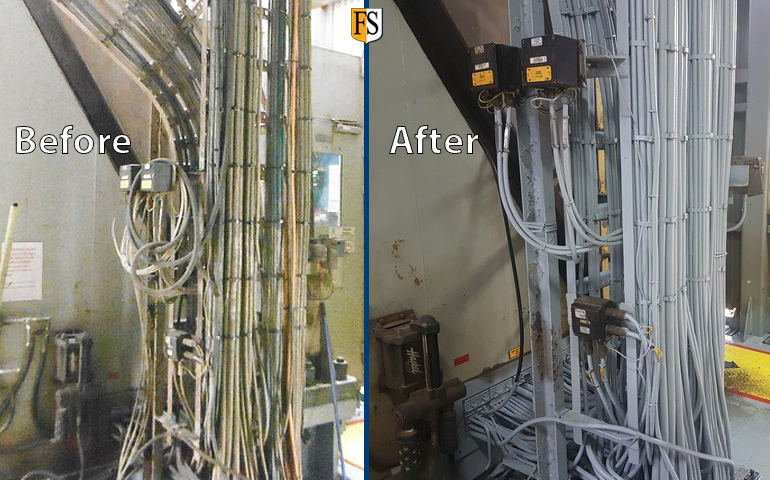
Typical cable cracks on offshore rigs.
A fire put lives at risk and result in costly downtime for the platform. Establishing and maintaining proper safety training and routines is essential to reduce risk. Avoiding damage to equipment and cables is also a high priority for most operators. But in recent years, with lower oil prices and high production costs, there is an increasing concern about the cost of maintenance as cables can pose a significant share of the maintenance budget.
Fire Security conducts platform surveys for many operators, and we often discover that cable maintenance is long overdue. Through years of experience, we have developed a cost-effective solution to this safety challenge. We offer cable repair, fire protection, and protection from environmental and mechanical damage in a turnkey delivery.
What are the leading causes of cable wear and damage?
Cable deterioration can occur in numerous ways and within different time frames. Sometimes we observe early signs of wear even with newly installed cables. The UV radiation from sunlight degrades cables over time. Chemicals, water, mud, excessive heat or cold, and mechanical movement are other typical treats to the longevity of electrical cables. As cables are aging, cracking of the insulation occurs, potentially causing a short circuit.
Fire Security’s coating prevents fire disasters.
A short circuit may start a fire, and even small fires can rapidly propagate using cable trays as a pathway. FS coated cables cannot burn and don’t spread the fire. Fire Security’s coating prevents the release of poisonous gas and fumes from cables.
Our coating system ensures that signal/power passes through the cables when it is needed the most. The coated cables are reusable if the fire extinguishes within a reasonable time. In this case, you do not need to replace any cables as a result of the fire incident. The FS coating also upgrades the cables insulation value and increases the life expectancy of the cables’ outer sheath.
A typical cable repair procedure.
Here is a recap of a cable repair project on an oil-rig in a shipyard in Singapore. Paul Filby from Fire Security led our 6 men application team.
We carried out the cable repair following our approved repair method.
Firstly the cables were all pressure cleaned and degreased. On the cable tray under the drill floor aft, it was necessary to remove the banding from the top cable tray to fully access the 2nd tray. Oil soaked debris on top of the trays were scraped off, and pressure cleaning took a full 3 days before the cables were fully degreased.
We removed cables that were spilled open and removed damaged sheath sections. We rebuilt the cable sheath using our FS17 repair tape and applied 2 coats of FS5 by brush.
Cables were then re-bundled using cable ties and reattached to the tray using SS banding. Masking around the cables with tarpaulin and plastic sheeting was carried out to prevent overspray of our coating. Next, we sprayed the cleaned cables with two layers of FS5.
Finally, we inspected the work and issued a warranty certificate to the rig operator.
Fire Security has worked with major oil & gas companies worldwide, check out our reference list.






